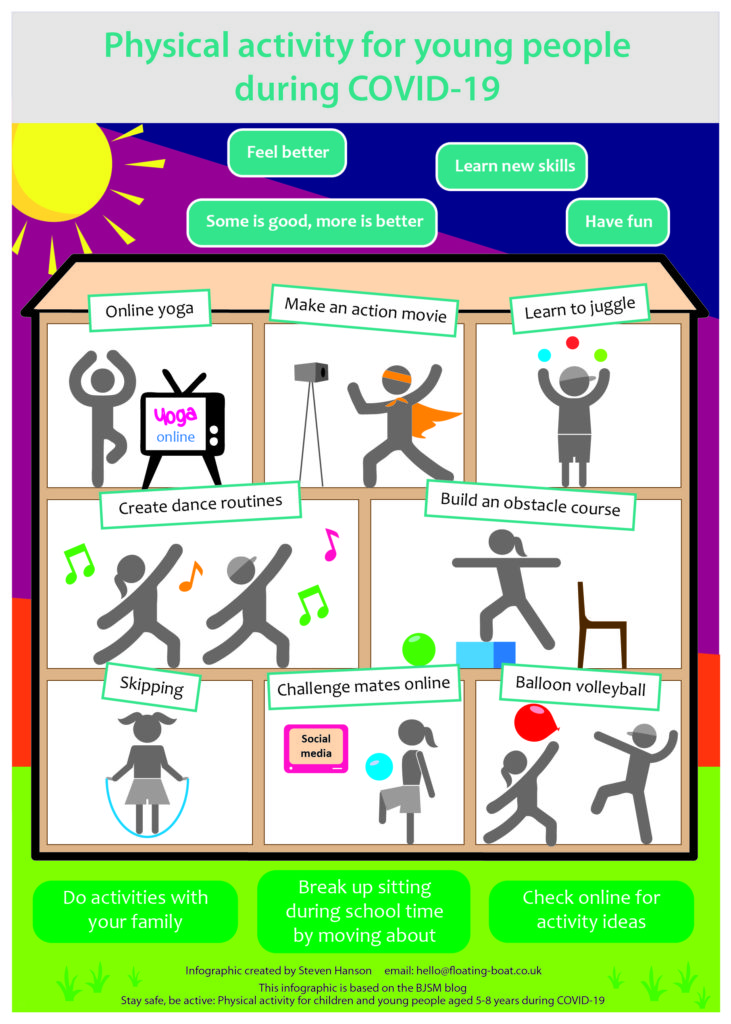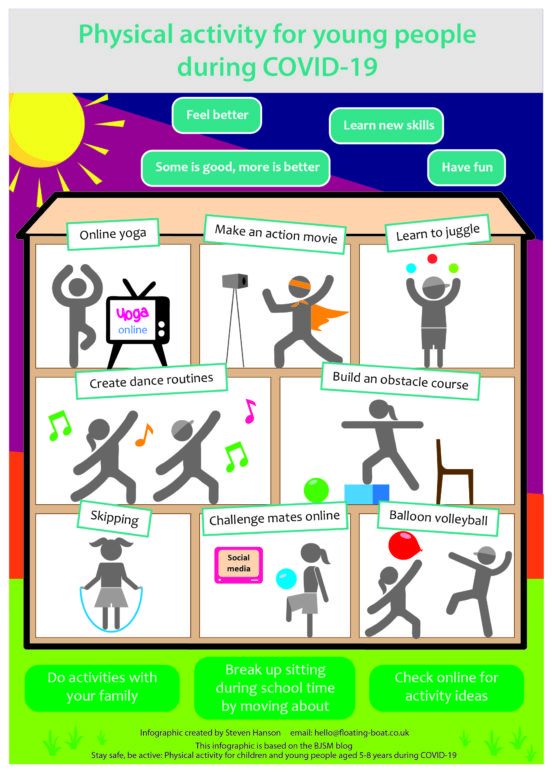Researchers from the Physical Activity for Health Research Centre (PAHRC) in Moray House School of Education and Sport have been contributing to a series of blogs in the British Journal of Sports Medicine that aim to promote physical activity during Covid-19. These blogs have focused on adults, ‘at risk’ populations, and in this blog that follows on children and young people aged 5-18. Each blog is accompanied by an infographic to summarise the blog, and present the information in a public-facing format. In this blog, led by Dr Sam Fawkner and Dr Ailsa Niven, we draw on current evidence to focus on why children should be active, provide examples of activity, and importantly outline how to encourage this activity.
Covid-19 presents many challenges and anxieties. For parents and carers of school-aged children (young people), daily lives are barely recognisable. We are attempting to juggle work, life and schooling from home, while trying to keep everyone happy. The benefits of physical activity for young people are widely recognised, and during COVID-19, moving more and sitting less is very important to help families maintain physical and mental health. Being confined to home means that young people, who are used to school P.E., after school activities, active travel, organised sport and outdoor play, have to find a ‘new normal’. Screen use, which is mainly sedentary, has likely increased because of the switch to online education, entertainment and ‘babysitting’ services for overstretched parents.
In this blog, we focus on why encouraging our children to move more and sit less (if they can) is a priority at this trying time. We deliberately focus on being inside; although if guidelines allow, getting outside is also beneficial.
WHY?
Young people ideally should accumulate 60 minutes of at least moderate intensity activity a day; this can involve lots of short bouts of physical activity and a range of intensities. Over the week, activities should include some that stress muscles and bones (like yoga and jumping) and some to help promote movement skill (involving balance, coordination and body awareness). These guidelines are based on evidence that more active young people have better health outcomes, including cardiovascular and bone health, muscle fitness and weight status.[1] There is also evidence that increased physical activity is associated with enhanced mental health, improved cognitive (mental) function, aspects of self-esteem, and reduced depressive symptoms in young people.[2, 3] As with adults, immediate benefits of each bout of activity may include reduced anxiety and a ‘feel good’ effect.[1]
what?
Activity ideas: games and yoga
Although there is limited evidence about the benefits of specific home-based activities for young people, any activity that gets your child moving is beneficial. Activity ideas include playing traditional playground games indoors (e.g. hide and seek, tag, skipping), dancing to music, and getting creative (e.g. building an obstacle course, playing balloon volleyball, making an action movie or learning to juggle). Check for age appropriate web-based activity programmes, such as The Body Coach. Yoga has a range of positive benefits for young people and everyone can do it at home. Try Cosmic Kids or The Yoga Crow. A range of organisations offer ideas for home-based activities (e.g. Active Schools, Change for Life and SportEngland). Try a few different activities and alternate them to keep young people interested. While 60 minutes a day is ideal, it may not always be achievable. Just remember that any opportunity to move more and sit less is good.

Moving more to help home-schooling, or combining them!
Physical activity (performed regularly as well as just a single bout) can help young people’s cognitive function and their attention.[4, 5] So, a short bout of activity is a great way to break up periods of school work or screen use, and also help them focus on their work. As well as the suggestions above, GoNoodle provides a series of short fun activity breaks for primary school children.
Combining physical activity with learning has cognitive benefits [6] and is fun, especially with younger children. Turn ‘Simon says’ into a maths game, ‘Simon says jump 4+5 times’. Do an activity (jump, burpee etc.) the number of times shown on a pair of dice or a playing card. Count how many times you can hit a balloon between you. Ask your child to spell out a word, and find objects in the house that begin with each of the letters as fast as they can. The opportunities are endless.
Moving more to break up sitting time
Sitting for long periods (especially when using screens) is associated with poor physical and mental health outcomes in young people.[7, 8] If able, interrupting sitting time regularly with brief periods of movement will help, as will swapping sedentary gaming for active gaming.[9] In school-based settings, young people are happy to work for short periods while standing, rather than sitting.[10] Try creating a makeshift standing desk, which the whole family could use.
HOW?
Motivating young people to move more
Despite our best intentions to encourage physical activity, every parent or carer has been faced with ‘but I don’t want to….go on a walk….dance…etc’. Recent research provides guidance on how to create the best motivational environment to enhance physical activity and well-being.[11-13] It isn’t rocket science to realise young people will be more motivated to engage in fun and enjoyable activities. Focus on the 3Cs of Competence, Control and Connectedness.
Competence; we are motivated to engage in and enjoy doing activities that we feel we can do. 1) Try to select activities for young people that are achievable but also challenging (if too easy, ask them ‘how could we make this harder – I think you could do more’). 2) Provide feedback to build feelings of competence; focus your feedback on self-improvement and effort ‘you worked really hard at that, and got better’, and try to avoid comparisons with others ‘but your sister can do that really well’. 3) Encourage your child to set achievable goals and keep a record to monitor progress. We don’t know a great deal about the value of young people using wearables and apps to track physical activity, but if you have them, they could be a way for your child to set and monitor goals. Remember to be realistic given the current circumstances; unrealistic goals are unachievable and demotivating.
Control; relates to engaging your children in decision making, and providing opportunities for choice. Let your children choose what activity to do (give them up to four options), when, and who with. Be creative and include variety (the links above will help). Try ‘kids in charge’ sessions! Feelings of control can be enhanced if we provide a reason for why we are being active (focus on immediate positive outcomes – ‘it will be fun and will help us all feel better’), and try to minimize controlling language (‘must’, ‘should’, ‘have to’).
Connectedness; relates to feeling supported and connected with others. For some young people this could be achieved by parents/carers being active with them in a way that helps them feel competent and in control (see above). Getting involved and having fun models positive behaviour, and provides a focus for family time. For some young people, connecting with their peer group through activity will help (e.g., online or by phone).
The 3Cs provides guidance, but no parent or carer will be able to adhere to them 100% of the time, and that is O.K. (https://selfdeterminationtheory.org/parenting/). At this time, it is especially important to be kind to ourselves. Many of us are anxious and emotional (as are our children). Sometimes the time isn’t right – so don’t force it. Try again another time.

We hope that you find this useful to help keep our children active at this challenging time. We’ve drawn from the latest scientific evidence, and our experiences as parents. Stay safe and be active when you can.
Samantha Fawkner 1 (corresponding author) @s_fawkner, Ailsa Niven 1 @AilsaNiven, Steven Hanson 2 @SteveFloatBoat, Chloë Williamson 1 @Chlobobs_, and Coral L Hanson 3 @HansonCoral
1 Physical Activity for Health Research Centre, Institute for Sport, Physical Education and Health Sciences, University of Edinburgh, Edinburgh, UK Email: s.fawkner@ed.ac.uk
2 Floating Boat Design Solutions, Stocksfield, UK
3 School of Health and Social Care, Edinburgh Napier University, Sighthill Campus, Edinburgh, EH11 4DN, UK
Competing interests
Website and YouTube links are provided for illustrative purposes. Dr Fawkner has an on-going professional relationship with The Yoga Crow. The authors have otherwise no affiliation to any of the organisations or companies referred to, and cannot comment directly on the activities promoted.
References
- Department of Health and Human Services. 2018 Physical Activity Guidelines Advisory Committee Scientific Report [date accessed April 2020] https://health.gov/sites/default/files/2019-09/PAG_Advisory_Committee_Report.pdf; 2018
- Biddle SJH, Ciaccioni S, Thomas G, et al. Physical activity and mental health in children and adolescents: An updated review of reviews and an analysis of causality. Psychol Sport Exerc 2019;42:146-55. doi: 10.1016/j.psychsport.2018.08.011
- Dale LP, Vanderloo L, Moore S, et al. Physical activity and depression, anxiety, and self-esteem in children and youth: An umbrella systematic review. Ment Health Phys Act 2019;16:66-79. doi: 10.1016/j.mhpa.2018.12.001
- de Greeff JW, Bosker RJ, Oosterlaan J, et al. Effects of physical activity on executive functions, attention and academic performance in preadolescent children: a meta-analysis. J Sci Med Sport 2018;21(5):501-07. doi: 10.1016/j.jsams.2017.09.595
- Donnelly JE, Hillman CH, Castelli D, et al. Physical Activity, Fitness, Cognitive Function, and Academic Achievement in Children: A Systematic Review. Med Sci Sports Exerc 2016;48(6):1197-222. doi: 10.1249/mss.0000000000000901
- Daly-Smith AJ, Zwolinsky S, McKenna J, et al. Systematic review of acute physically active learning and classroom movement breaks on children’s physical activity, cognition, academic performance and classroom behaviour: understanding critical design features. BMJ Open Sport Exerc Med 2018;4(1):e000341. doi: 10.1136/bmjsem-2018-000341
- Rodriguez-Ayllon M, Cadenas-Sánchez C, Estévez-López F, et al. Role of Physical Activity and Sedentary Behavior in the Mental Health of Preschoolers, Children and Adolescents: A Systematic Review and Meta-Analysis. Sports Med 2019;49(9):1383-410. doi: 10.1007/s40279-019-01099-5
- Tremblay MS, LeBlanc AG, Kho ME, et al. Systematic review of sedentary behaviour and health indicators in school-aged children and youth. Int J Behav Nutr Phys Act 2011;8:98. doi: 10.1186/1479-5868-8-98
- Sween J, Wallington SF, Sheppard V, et al. The role of exergaming in improving physical activity: a review. J Phys Act Health 2014;11(4):864-70. doi: 10.1123/jpah.2011-0425
- Verloigne M, Ridgers ND, De Bourdeaudhuij I, et al. Effect and process evaluation of implementing standing desks in primary and secondary schools in Belgium: a cluster-randomised controlled trial. Int J Behav Nutr Phys Act 2018;15(1):94. doi: 10.1186/s12966-018-0726-9
- Ha AS, Ng JYY, Lonsdale C, et al. Promoting physical activity in children through family-based intervention: protocol of the “Active 1 + FUN” randomized controlled trial.(Report). BMC Public Health 2019;19(1) doi: 10.1186/s12889-019-6537-3
- Lubans DR, Lonsdale C, Cohen K, et al. Framework for the design and delivery of organized physical activity sessions for children and adolescents: rationale and description of the ‘SAAFE’ teaching principles. Int J Behav Nutr Phys Act 2017;14(1):24. doi: 10.1186/s12966-017-0479-x
- Morgan PJ, Young MD, Barnes AT, et al. Engaging Fathers to Increase Physical Activity in Girls: The “Dads And Daughters Exercising and Empowered” (DADEE) Randomized Controlled Trial. Ann Behav Med 2019;53(1):39-52. doi: 10.1093/abm/kay015
Reproduced from Fawkner S, Niven A, Hanson S, Williamson C, Hanson C.L. (2020). Physical activity for children and young people aged 5-18 years during COVID-19. Stay safe; be active. British Journal of Sports Medicine Blog Published Online First: (13/04/2020).https://blogs.bmj.com/bjsm/2020/04/13/physical-activity-for-children-and-young-people-aged-5-18-years-during-covid-19-stay-safe-be-active/ with permission from BMJ Publishing Group Ltd.











Comments by Ritti Soncco